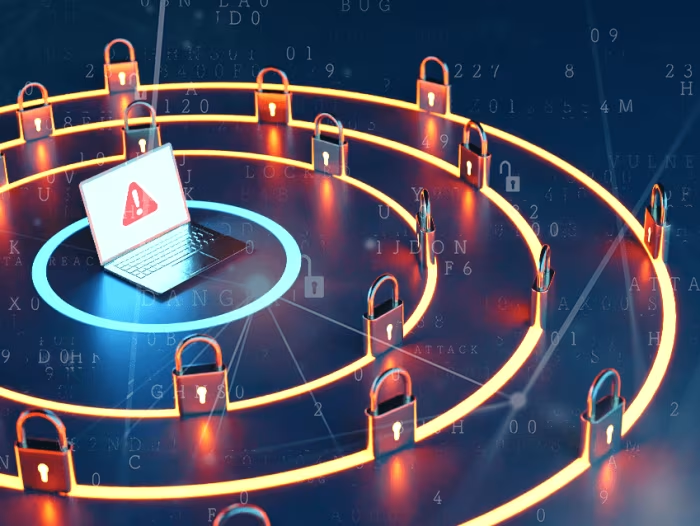Resource / Online Journal
Effective Cyber Defense for Enterprises: Key Strategies for Success
Discover effective cyber defense strategies for enterprises to protect against evolving threats. Learn key tactics for building robust security and ensuring business success.
Published on Dec 24, 2024

In today’s tech-driven world, cyber threats are a constant and evolving challenge for enterprises of all sizes. From ransomware to phishing attacks, the risks to personal data and business operations are ever-present. Cyber protection for enterprises has become more than just an IT issue; it’s a fundamental part of ensuring that an organization can thrive and maintain its reputation. The right strategies can protect valuable data, prevent costly security incidents, and ensure business continuity. This blog outlines essential strategies for enterprise protection and highlights the importance of a proactive and well-rounded cybersecurity approach.
1. The Need for Strong Cyber Defense in Enterprises
Enterprises are prime targets for cybercriminals due to the sheer volume of private data they manage. Enterprise cyber security for enterprises isn't just about installing a firewall or antivirus software; it’s about creating a robust, multi-layered approach that covers every angle. From data protection to secure communication and continuous monitoring, these strategies need to work in harmony to defend against both external and internal threats. Implementing a strong enterprise cyber security strategy is essential to minimizing risk and protecting the long-term success of the organization, ensuring that enterprise cyber security remains a priority at all levels.
2. Understanding Sensitive Data and its Importance
Sensitive data is the lifeblood of any organization, encompassing everything from personal customer information to proprietary business strategies. The protection of this data must be a top priority, as any breach could lead to significant financial losses, regulatory fines, and lasting reputational damage. Enterprises must be diligent in safeguarding their private data with encryption, secure access protocols, and continuous monitoring, ensuring robust enterprise security actions are in place. Without this level of protection, companies are vulnerable to cyberattacks that can exploit weaknesses in their defenses, making enterprise security essential for long-term protection. Enterprise security must be continuously evaluated and updated to stay ahead of emerging threats.
3. Key Principles of Enterprise Cybersecurity
At its core, enterprise cybersecurity is about securing networks, systems, and data from malicious attacks. It’s crucial for enterprises to implement robust security controls such as firewalls, secure access systems, and continuous threat recognition. These measures must be complemented by clear policies and procedures that ensure both employees and management understand their role in maintaining cybersecurity. A layered approach to defense, which combines technology with well-defined processes, is vital for achieving comprehensive protection.
4. The Growing Threat of Cyberattacks
The landscape of cyber threats is rapidly changing, with cybercriminals becoming more sophisticated in their tactics. Gone are the days of basic viruses; today, hackers are deploying advanced persistent threats (APTs), zero-day exploits, and social engineering schemes to gain rights to critical systems. The consequences of such breaches can be devastating, impacting everything from customer trust to operational efficiency. Organizations must stay ahead of these evolving threats by regularly updating security protocols, performing penetration tests, and investing in cutting-edge security solutions.
5. Importance of Protecting Critical Data
Critical data forms the foundation of any enterprise’s operations, and without it, business continuity can come to a halt. Protecting this data is essential not just for business activities but also for ensuring compliance with data protection regulations. For example, organizations must implement strict data access controls to prevent unauthorized individuals from viewing or altering sensitive information. Data protection, secure backup solutions, and multi-factor authentication (MFA) are essential tools for protecting critical data and ensuring that the organization can continue to operate securely.
6. Minimizing Risks from Data Breaches
Data breaches can lead to severe financial and reputational consequences, and they are often caused by a combination of weak security measures, human error, and outdated systems. Implementing encryption, securing endpoints, and enforcing strict user access policies can mitigate the risk of a data breach. Additionally, organizations should have a breach response plan in place so that they can act quickly if a breach occurs. The key is to always stay ahead of potential vulnerabilities and continually assess and update security measures.
7. Multi-Layered Approach to Enterprise Cybersecurity
A multi-layered cybersecurity approach is essential for building a resilient defense system. This approach involves using a combination of tools and techniques such as firewalls, intrusion detection systems (IDS), antivirus software, and encryption. By diversifying your security measures, you ensure that even if one layer is compromised, the others remain intact. This redundancy helps prevent attackers from easily gaining access to private data or disrupting business operations.
8. Proactive Threat Detection
Threat detection is not something enterprises can afford to overlook. Cybercriminals are skilled at infiltrating systems and remaining undetected for long periods, which is why proactive threat detection is essential. Real-time monitoring, intrusion prevention systems, and behavioral analytics are all important components of an effective threat recognition strategy. By identifying unusual patterns or activities early on, companies can mitigate potential damage before a breach occurs.
9. Role of Antivirus Software in Cyber Defense
Antivirus software plays a critical role in protecting enterprises from malicious software such as viruses, worms, and ransomware. It is the first line of defense in scanning business computers, servers, and networks for threats. However, it’s not enough to rely solely on antivirus software. It must be part of a broader cybersecurity strategy that includes regular updates, employee training, and incident response planning to ensure that all threats are effectively addressed.
10. Implementing Strong Security Controls
Security controls such as firewalls, intrusion Security systems, and user access controls form the bedrock of enterprise cybersecurity. These controls should be tailored to the specific needs of the organization, considering factors such as network structure, business size, and regulatory compliance. Regularly updating and reviewing these controls is critical to staying one step ahead of cybercriminals, who are constantly adapting their methods to exploit weaknesses in security systems.
11. Combatting Cyber Attacks Effectively
Cyberattacks, including ransomware and phishing, are designed to disrupt business operations and steal valuable data. A well-prepared organization will have secure backups in place, disaster recovery plans, and trained staff who know how to recognize the signs of an attack. By isolating critical systems like payment processing networks and ensuring access is limited to only trusted personnel, businesses can prevent an attack from spreading across the entire network.
12. Addressing Advanced Persistent Threats (APTs)
Continuous cyber threats are stealthy and long-lasting attacks where cybercriminals gain access to a network and maintain their presence over time. These threats require continuous vigilance and advanced detection techniques to prevent them from succeeding. Enterprises must regularly monitor for abnormal behavior, patch known vulnerabilities, and stay updated with the latest cybersecurity trends to defend against APTs.
13. Strengthening Authentication with Multi-Factor Authentication
Multi-factor authentication (MFA) is an essential defense mechanism to secure enterprise systems. MFA requires users to verify their identity using multiple methods, such as a password and a biometric scan, reducing the chances of unauthorized access. Enabling MFA across all critical systems significantly strengthens the organization's overall cybersecurity posture.
14. Controlling Administrative Privileges
Administrative privileges give users access to sensitive systems and data, making it crucial to limit these privileges to only those who absolutely need them. By applying the principle of least privilege, enterprises can minimize the risk of internal threats and accidental data leaks. Role-based access control (RBAC) is one of the most effective ways to manage administrative access.
15. Importance of Intrusion Detection Systems
Intrusion prevention systems are essential for identifying and responding to security threats in real time. These systems monitor network traffic and user activity for unusual patterns, including potential issues related to the service set identifier, and can alert administrators when potential threats are detected. By acting on these alerts quickly, organizations can prevent a breach or limit the damage caused by an attack.
16. Safeguarding Business Operations
Cyberattacks not only threaten private data but also the smooth functioning of business activities. Ensuring that all critical business activities, from payroll to supply chain management, are protected with robust cybersecurity measures is essential for avoiding disruptions caused by cybersecurity threats. A secure business environment, supported by secure programs, fosters productivity and strengthens an enterprise’s resilience against potential attacks.
17. Securing Operating Systems
Operating systems are often the target of cybercriminals looking for vulnerabilities to exploit. Regular patching, system hardening, and restricting user access to administrative controls are essential practices for securing operating systems. Ensuring that only authorized key personnel can make changes to the system is vital for reducing exposure to cyber threats. Additionally, utilizing anti-fraud services to protect company data is crucial in preventing unauthorized access and potential breaches.
18. Protecting Network Devices
Network terminals such as routers, switches, and wireless access points are gateways into an enterprise's internal systems. Securing these devices with proper configurations, encryption, and access controls is vital for preventing unauthorized entry. Government agencies may also be involved in setting guidelines for securing such devices. Additionally, enterprises must ensure to encrypt data transmitted through these terminals to further protect sensitive information. A breach in a network device can lead to a compromise of the entire network, making it essential to implement a secure device management policy.
19. Leveraging Security Technologies
Advanced security solutions like AI-driven threat detection and machine learning are transforming enterprise defense against cyber threats. These technologies analyze data in real-time, detect anomalies, and prevent attacks, protecting customer data. They also control physical access to sensitive systems, ensuring only authorized users interact with critical assets. Adopting these technologies is crucial for staying ahead of evolving threats.
20. Securing Wireless Networks
Wireless networks are particularly vulnerable to cyber threats, including unauthorized access and eavesdropping. Securing wireless networks with strong encryption protocols such as WPA3, limiting physical access to network equipment, and ensuring that wireless access points are properly configured can significantly reduce the risk of attacks. Additionally, using a virtual private network (VPN) can further protect customer data by encrypting communications across the network, ensuring that sensitive information remains secure.
21. Cybersecurity Best Practices for Enterprises
Adopting cybersecurity best practices is essential for creating a security-conscious culture within an organization. Best practices include regularly updating software, using strong passwords, conducting security audits, and training employees on how to recognize phishing attacks. Building these habits into everyday business activities will help ensure that all team members play an active role in keeping the organization secure.
22. Mitigating Insider Threats
Insider threats can be especially challenging to defend against because they involve individuals who already have trusted access to systems. By implementing strict access controls, monitoring user activity, and educating employees on security protocols, businesses can mitigate the risks posed by insiders and prevent data theft. Strong cyber security measures, including regular audits and employee training, further help in reducing vulnerabilities within the organization.
23. Strengthening Your Cybersecurity Strategy
A comprehensive cybersecurity strategy should be built on a foundation of regular risk assessments, vulnerability testing, and employee training, including cybersecurity awareness and phishing awareness. Organizations must continuously evaluate and update their cybersecurity measures to address emerging threats and changing business needs.
24. Encrypting Sensitive Data
Encryption is a powerful tool for protecting private data, both in transit and at rest. Ensuring that all confidential information is encrypted adds an additional layer of security that makes it much harder for attackers to exploit the data, even if they manage to access it. Furthermore, it is important to isolate payment solutions and implement strict controls around accessing data to minimize potential exposure to cyber threats.
25. Regular Security Audits and Penetration Testing
To stay ahead of evolving cyber threats and minimize cybersecurity risks, enterprises must regularly conduct security audits and penetration testing. These proactive measures help identify vulnerabilities in systems and networks, allowing businesses to patch weaknesses before they can be exploited, thus protecting the organization's digital assets.
26. The Value of Data Backup
Data backups are critical for recovering from a cyberattack or system failure. Regularly backing up data and storing it securely, preferably in an offsite location, ensures that business-critical information can be quickly restored if needed, minimizing the impact of data breaches. By maintaining proper backups, businesses can also mitigate the risk of data breaches and avoid losing valuable data in the event of an attack or failure.
27. Securing Cloud Environments
With many businesses moving their operations to the cloud, securing these environments is more important than ever. Implementing strong access controls, encryption, and regular monitoring of cloud services ensures that data stored in the cloud remains protected from unauthorized access, helping to mitigate cybersecurity risks. Additionally, it’s crucial to isolate payment solutions in the cloud to further protect sensitive financial data from potential threats.
28. Securing Internet Connections
Secure internet connections are essential for protecting data as it travels across networks. VPNs, SSL/TLS encryption, and secure Wi-Fi protocols help ensure that sensitive information remains safe from cyber criminals intercepting data during transmission and prevent data leaks that could expose confidential information.
29. Protecting Payment Systems
Payment solutions, such as credit card processing and online payment gateways, are prime targets for cybercriminals. Implementing secure payment methods, encrypting transactions, and regularly auditing these systems are essential steps for safeguarding financial data, making enterprise cybersecurity important. Additionally, managing user permissions effectively ensures that only authorized individuals have access to sensitive financial information.
30. Proactive Measures Against Cyber Incidents
Preventing cyber incidents is always better than reacting to them. By integrating proactive measures such as security awareness training, regular software updates, and a robust incident response plan, small businesses can significantly reduce the likelihood of a successful attack. Additionally, establishing a separate user account for administrative tasks helps limit potential vulnerabilities and enhance overall security.
31. Role of Penetration Testing in Cyber Defense
Penetration testing allows small businesses to simulate cyberattacks to identify vulnerabilities in their defenses. By finding weaknesses before attackers do, small businesses can fix critical flaws, isolate payment systems, and strengthen their overall security posture, reducing potential cybersecurity risks.
32. Password Management Best Practices
Implementing strong password management practices is a cornerstone of enterprise security. By enforcing policies such as regular password changes, using password managers, and ensuring that employees follow best practices for password security, organizations can prevent unauthorized access, strengthening overall enterprise security. This proactive approach plays a critical role in maintaining enterprise security and safeguarding sensitive data.
33. Preventing SQL Injection Attacks
SQL-based attacks are among the most common types of cyber threats and online threats targeting websites and applications. By using secure coding practices, input validation, and regularly updating web application security protocols, businesses can effectively protect themselves from SQL injection.
34. Addressing Security Risks with Security Technologies
Emerging security solutions, including AI-powered threat detection, automated response systems, and advanced encryption techniques, are playing an increasingly important role in defending against cyber threats. By integrating these technologies into an organization’s security infrastructure, businesses can enhance their defense capabilities and react more quickly to emerging threats.
35. Ensuring Regulatory Compliance
Compliance with regulations such as GDPR, HIPAA, and PCI-DSS is vital for any enterprise. Failing to comply with data protection laws can result in hefty fines and loss of customer trust. Enterprises must adopt security policies and practices that not only protect data but also ensure compliance with applicable regulatory frameworks, even when using the same computer for various tasks. This adherence to regulations is essential for maintaining financial stability and avoiding the costly repercussions of non-compliance.
36. The Importance of Incident Response Plans
An effective incident response plan is crucial for minimizing damage during a cyberattack. It enables quick action to contain the breach, recover data, and restore systems. A well-prepared plan reduces downtime, financial losses, and protects reputation. Regular testing and updates ensure it remains aligned with evolving threats, helping businesses handle cyber incidents with confidence and resilience.
Conclusion
Cyber defense for enterprises requires a holistic and proactive approach. By implementing robust security strategies and continually adapting to emerging threats, organizations can safeguard their sensitive data, ensure compliance, and protect their reputation. With a comprehensive cybersecurity strategy in place, businesses can focus on growth and innovation, secure in the knowledge that their digital assets are protected from evolving cyber risks.
Recommended articles


The Top Benefits of Multifactor Authentication for Enhanced Security
Take Your Identity Strategy
to the Next Level
Strengthen your organization's digital identity for a secure and worry-free tomorrow. Kickstart the journey with a complimentary consultation to explore personalized solutions.